Canada
Thu, 24 Jul, 2025
Read in 12 minutes
I went to Canada - here is what I thought

This is not a typical travel guide, nor is it particularly a travel guide at all - I merely wish to present to you a collection of interesting observations and opinions following my travels in East Canada.
Itinerary
I suppose I should start with a rough itinerary, so here goes:
The trip lasted a total of 17 days, including travel time, and was centred around 7 different locations which were, in order of appearance: Québec, Tadoussac (St. Lawrence River), Montréal, Ottawa, Whitney (Algonquin Park), Niagara Falls, and Toronto.
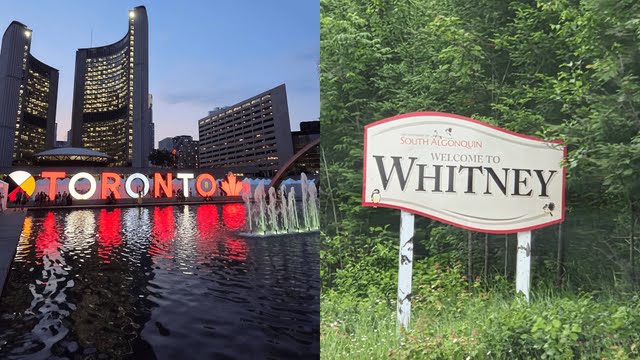
From Toronto to Whitney
As I was travelling around, each of these centres occupied only 1 to 3 days of the trip each and it was, therefore, necessary to ‘live out of a suitcase’ for the trip such that an egregious amount of time was not spent unpacking and repacking, and items did not get forgotten!
Provinces
Canada has a grand total of ten provinces (at least according to the omnipotent Wikipedia) and during my trip, I had the pleasure of exploring just two: Quebec and Ontario. I exhibit these now as diametric friends - as different as it gets for the same country.
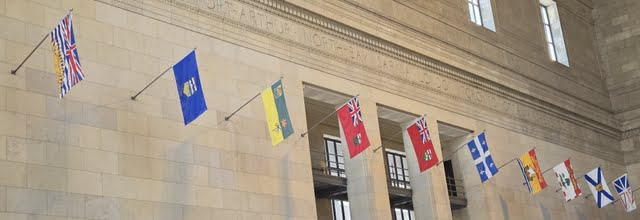
Can You Count to 10?
Quebec is a province defined by the St Lawrence river and what I picture a French-designed USA to look like, whilst Ontario is dominated by the Great Lakes and, as a direct comparison, a Britain designed by the US Founding Fathers.
True to form, the primary language of Quebec is French, whilst Ontario’s is English (no comment on American vs British here…) - although both languages are spoken in both provinces and the first thing you will hear after touching down on Canadian soil is the elegant “Bonjour, Hi.”
As you may imagine from my vivid descriptions, there are architectural differences, with Quebec feeling, on the whole, much older than its eastern counterpart and with just a touch more class. All of Canada is modern by UK standards, and its abundance of space means that large boulevards are the norm and clover-leaf interchanges are the four-way transport solutions of choice - how American!
Running the Maths…
Canada is the fourth largest country in the world by land area at 9,093,507 square kilometres, working out as just over 37 United Kingdoms (at 242,741 km2), and the second by total area (9,984,670 km2) with 8.9% of its total area comprising of water. Quebec and Ontario are the two largest provinces by total area in that order, whilst the order is switched if measuring by population. Interestingly, the largest territory is Nunavut, which has almost twice the area of Ontario - making it the largest administrative division by area.
Metric?
One of my favourite games to play when visiting a new country is: Are they metric? And this trip was no different! (I know, I play sad games…) So, how metric is Canada?
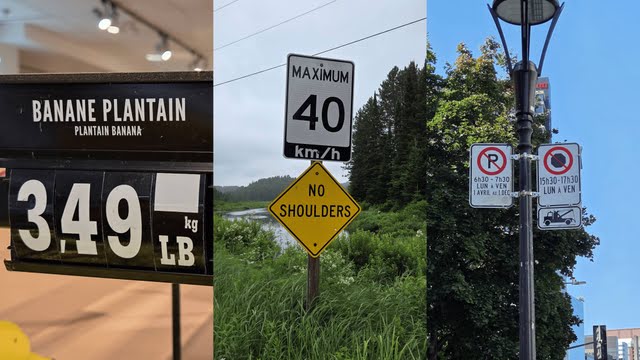
My Definition of Gaming is Different to Yours
From the collection of images above, I am conflicted about whether or not to pronounce Canada metric, grocery stores still use pounds (that strange ‘lb’ symbol) for a start! So, it might help to understand the history of metrication: much like the UK, Canada began metrication in 1971 and this saw the government urge many different industries and companies to switch to an SI-unit based measurement system. And they were more successful than us! Canada made the difficult switch to metric road signs in 1977, and its currency had already been decimal for decades - two of the most difficult factors solved seamlessly. Thus, Canada really is metric.
However, I am still saddened to see bananas measured in pounds and beer in pints. It appears consumers still find metric difficult in some cases.
As a side note, I was particularly pleased to find that road sign times use the 24 hour clock - how novel! I have long wished that the UK adopted 24 hour times for parking restrictions, but alas! We are stuck with the old-fashioned am and pm system.
Quite the Length!
Canada also boasts the world’s longest coastline which is a whopping 265,523 (CIA) or 202,080 (WRI) kilometres. Note the differences in length; this is important. Coastline length is a heavily contested figure, with different organisations and groups claiming different lengths due to a phenomenon known as the coastline paradox. The paradox is that higher resolutions of coastline lengths will provide much larger results than those at lower resolutions - leading to heavily contested measurements!
Food
It says rather a lot about a country that their national dish consists of fries, gravy, and cheese curds - I am of course referring to the famous poutine - but their wear it like a badge of honour and surprisingly have a lower obesity rate than the UK!
Poutine is an interesting dish, chips and gravy I can certainly get behind as one of our fish and chip shop favourites alongside curry sauce and mushy peas. However, the addition of cheese curds is baffling: they add almost nothing to the flavour and have a somewhat confusing rubbery texture; it is almost as though cheese curds were added purely to increase the cholesterol of the general populous. But, a national dish it remains, and it is definitely worth a try - especially with bacon!
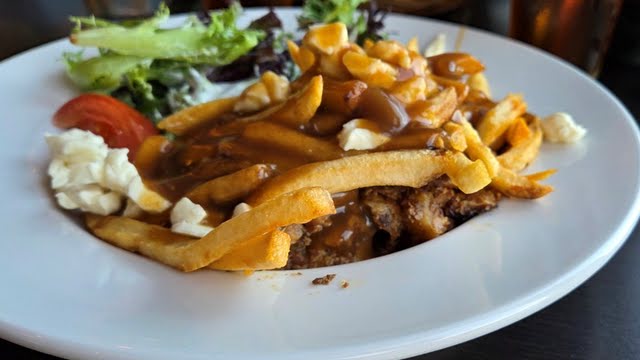
Two Classics in One
I was fortunate enough to sample my poutine with tourtière, French Canada’s answer to a meat pie, consisting of pork, beef, potatoes, and onions in a rich gravy usually encased in a lovely pastry case. The version I was served lacked the pastry, instead replacing it with poutine to cut down on the carbs - my body thanks them. The review? It is very nice if you are a fan of beef and pork, which just so happen to be my least favourite meats… I did enjoy it though!
Of course, Canada is no stranger to fast food - it is somewhat unavoidable given its proximity to the USA. But, whilst Canada does have the now ubiquitous McDonald’s, KFC, and Dairy Queen, it also has its own offering: A&W, Tim Hortons, and Pizza Pizza. Together, these chains cater for most fast food tastes: A&W offers the traditional burgers, chicken, and fries, but with a Canadian twist - root beer. Is it any good? I have no idea, root beer is not my thing.
Tim Hortons hosts the ‘Dunkin Donuts’ experience north of the border, with sweet baked goods and enough caffeine to sink a small battleship. Their most notable item is donut holes, which they delightfully call timbits - available to buy individually (why?) and as packs of 10, 20, and 50.
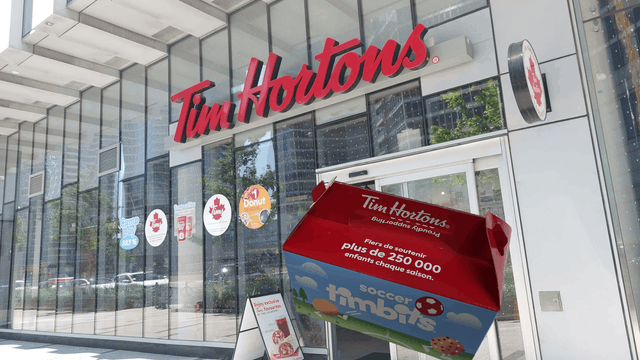
The Prodigal Baker Doth Provide
Finally, Pizza Pizza does exactly what it says on the tin: pizza. Canada’s answer to Domino’s is nothing to write home about, but it is a high street staple with almost 60 years of experience.
If you, like me, get excited by holey baked goods, it may interest you to know that Montréal is one of the bagel capitals of the world. St-Viateur Bagel is Montréal’s bagel institution, with 5 locations serving 10 different bagel types and a choice of 11 fillings! Its Mont-Royal location is the best place to go for a bagel lunch, breakfast, or even dinner (at a push).
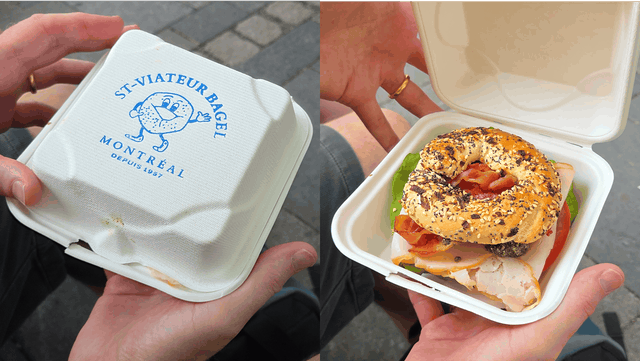
What’s In the Box?
I can highly recommend the all dressed club bagel (not pictured - it did not last long…).
Ecstatic? I’m Electric!
Canada’s electrical system is three-phase, with three 120 V 60 Hz phases at 120 degrees to each other. Standard outlets provide one of these phases (120 V 60 Hz), and two phases are tied to produce 240 V for high-power appliances (in kitchens, etc.). The North American standard type A sockets are used throughout the country with 15 A ratings, and high-use sockets are often loose as springs wear over time. GFCI is a common feature in bathrooms, but there are no installation-wide ground fault protections.
The Natural World
During the trip, I visited both Tadoussac’s Sentier dunes and the Algonquin Provincial Park (via Whitney). Canada has some fantastic and remarkable landscapes and animals, which I thoroughly enjoyed exploring and cannot recommend highly enough.
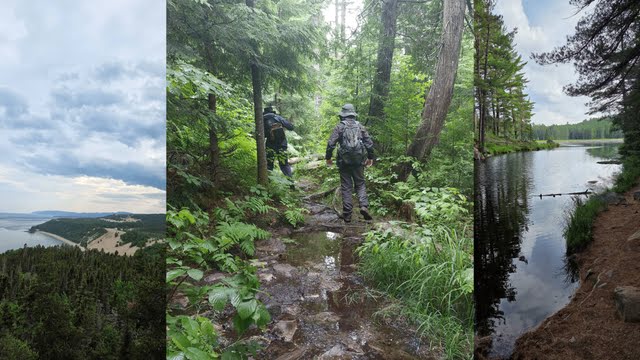
Nature At Its Finest (L: Sentier dunes, C&R: Algonquin Provincial Park)
If you are planning a visit, the Sentier dunes are fairly out of the way and might take a little bit of research - there is a viewing platform not too far from the dunes which gives a great view accessible via a short trail.
Algonquin Park follows the route of Ontario’s Highway 60 and hosts over 20 interpretive walking trails ranging from 200 m to 10.8 km, taking in a variety of habitats and environments. I walked the Fire Tower, Beaver Pond, Fork Lake, and Mizzy Lake trails - although I only got halfway around the last trail, more on that later…
There are many activities besides just walking to do in the Canadian wilderness, though, and I had great success in canoeing around Opeongo Lake - the largest lake in the Algonquin Provincial Park - spending over three hours exploring just a tiny section of the lake.
However, I would like to give a word of warning to anyone else visiting: prepare for mosquitoes. Seemingly everywhere in Canada’s many forests are thousands of mosquitoes who all want a bite of you! Do not let this put you off, though, as there are many solutions to this common problem, which I will rattle off now in a small list:
- Mosquito and bug spray: This is a fairly obvious one, try to find the strongest mosquito spray you can - generally containing 30% DEET (as the legal limit for Canadian products - 50% in the UK).
- Mosquito nets: As a fairly extreme measure, mosquito face nets can be purchased that offer head and neck protection; these are a sure way to avoid bites and, when combined with long clothing, just leave hands exposed to be shoved into pockets for protection.
- Neutral clothing colours: This is a less well-known solution, but mosquitoes are actually attracted to certain colours of clothes, including navy, red, orange, and black. You can look this up, I am not joking.
- Smoke: If you are staying around the same area for a while, smoke will deter mosquitoes, and smoke coils can be purchased for just that purpose - give them a go!
Oh, and try not to stand too close to anyone - you do not want to get caught up in someone else’s mosquito cloud too!
A Tow Truck Towing Truck Towing Trucks
No, that is not a joke; it is entirely possible that you may find things that wild in Canada. During my trip, it became a regular occurrence to find vehicles towing unusual things - including other vehicles! Some of my favourites included cars towing three-wheeled trikes and even a motor home towing a car…
Currency
The Canadian Dollar (CAD) is the national currency of Canada and immediately served to impress me with modern designs for both coins and notes! Standard circulation coins begin with the 5, 10, and 25 cent coins (using a decimal system, $1 = 100¢), followed by the 1 and 2 dollar coins. 50 cent coins are minted, but have not circulated since 2004.
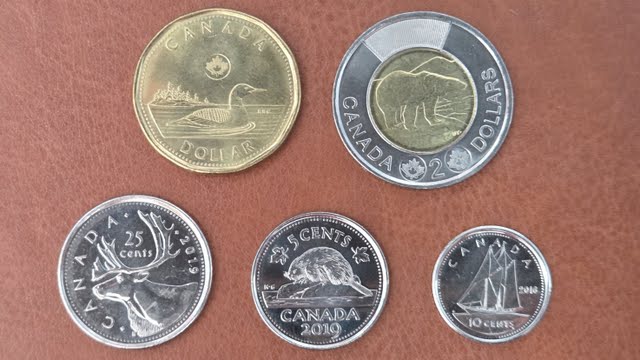
Ship, Beaver, Moose, Duck, Bear
As for the banknotes, the frontier series is the most common in circulation and features bold colours with portraits of important governing figures from Canada’s past. Banknote denominations include 5, 10, 20, 50 and 100 dollars. There is also a vertical 10 dollar banknote, and future designs are planned for other denominations - this is exciting!
Coins are currently in the process of changing to feature a portrait of King Charles III, and all banknotes still feature Queen Elizabeth II. This may sound strange - the King?! But, there is good reason: Canada is actually still a constitutional monarchy sharing the head of state with the UK.
It Just Makes Cents
Canada does not have a one cent coin. It sounds crazy, but it has been true since 2012 - you cannot get less than 5 cents in your change when paying in cash. This is because minting a cent became more expensive than a cent, which just does not make any sense! So, when receiving change, the totals are rounded up or down to the nearest 5 cents and you receive the difference. $1.99 really is a scam.
Government
The governmental system of Canada is composed of four elements which are designed to work together to centrally govern the country; these are:
- The Crown: The ruler of Canada by technicality, the monarch completes historical and traditional ceremonies alongside state appearances. The monarch deputises many official duties to the Governor General of Canada.
- Executive branch: The House of Commons is the democratically elected parliament and is responsible for writing new bills and acts which form the basis of the legal system alongside the constitution.
- Legislative branch: The Senate is comprised of senators appointed by the Governor General and acts as an additional approval point for any acts proposed by the House of Commons. Both the House of Commons (lower house) and the Senate (upper house) must vote and approve all acts before they are passed into law.
- Judicial branch: The Supreme Court is the highest court in the Canadian judicial system and arbitrates the law. Justices are appointed by the Governor General at the suggestion of the Prime Minister.
The Canadian parliament is located in buildings in Ottawa, and usually both the Senate and the House of Commons are located in the same building. Usually, because the building was under renovation during my visit, and thus the chambers had been relocated temporarily.
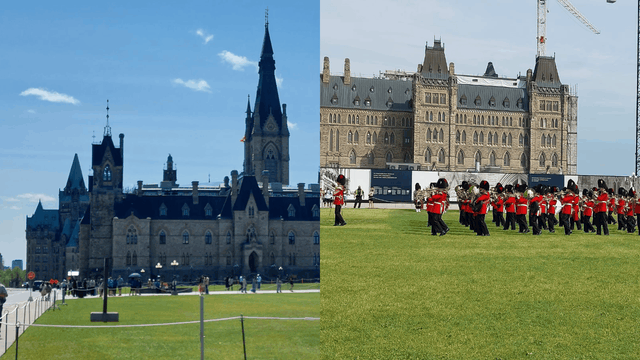
Enough Spires for Ya?
Each of the Canadian provinces also has its own government, responsible for the administration of the province.
If you visit the Canadian parliament at around 0945, you might just be lucky enough to catch the changing of the guard - a ceremony that lasts over an hour! During the change-over, the marching band treats spectators to a medley of Canadian pop, including Shania Twain and Avril Lavigne.
Harsh Conditions
Whilst exploring Canada, I saw many ways in which the population has adapted to deal with extreme temperature fluctuations. You see, whilst summer is hot at 27 °C, winter is also cold at −7 °C - data for Toronto in July (max) and January (min). A prominent feature in Quebéc (the city) is the high-pitched curved roofs, which make for pretty photographs but also ensure that snow does not collect and collapse the roof!
Closing Thoughts
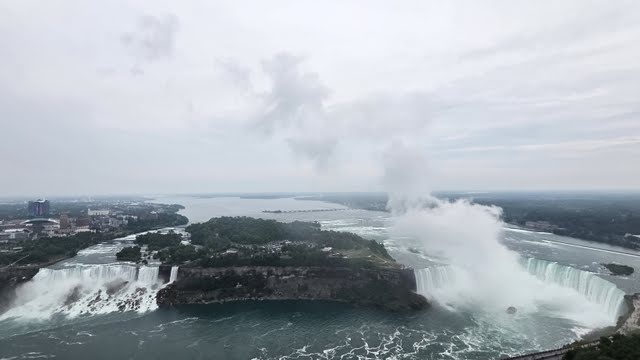
Worth the Trip?
Whilst my goal was not to provide a travel guide, I do hope that you might find this persuasive enough to consider a trip to Canada for yourself! I found myself marvelling at everything from architecture to beaver dams and so much more; it really is a fantastic place to go. Great food, great people and great places - all the boxes are ticked.
Sources
All images by me, Neo Skinner.
Data from Wikipedia.
Opinions entirely my own.